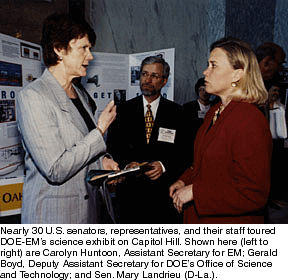
DOE-EM exhibit demonstrates strength through science to Congress DOE’s Office of
Environmental Management recently hosted a day-long exhibit on Capitol Hill to promote
congressional understanding of EM’s need for a strong science and technology program
and the key role it plays in cleanup efforts. Held April 10 in the Rayburn Foyer of the
U.S. House Organized around the problem areas of tanks, soil and groundwater contamination, and closure, the exhibit emphasized the themes of time and money saved, safety improvements, and enabling technologies. With approximately 100 science and technology solutions displayed, the exhibit also demonstrated the value of technology investment to DOE site and individual state programs. Attendees could see some of these technologies in action and on video, test the “cool suit” technology that protects workers, see how robots help achieve cleanup, and get information and questions answered from knowledgeable DOE staff. At an evening reception (sponsored by the Environmental Business Action Coalition and other companies), Assistant Secretary for Environmental Management Carolyn Huntoon thanked attendees for their interest, thanked all who helped generate the exhibit, and noted the challenge facing DOE in developing and communicating about science and technology results: “Science and technology is making a world of difference. It is helping us to clean up the waste left behind by the Cold War in a faster, cheaper, and safer way. With continued investment in science and technology, I believe we can revolutionize the cleanup by transforming it from a daunting, if not overwhelming, challenge to a very achievable mission in the years ahead.” Two U.S. representatives also addressed the group to express their support for EM and
for science and technology research and development. Rep. Doc Hastings (R-Wash.), who
sponsored the exhibition, welcomed all attendees and expressed support for the need for
science and technology. Rep. Nick Rahall (D-W.V.) recognized the need for bipartisan
effort to transform science into life-saving technology, the importance of public/private
partnerships, and the role of the International Union of
Operating Engineers. |
 of Representatives, “Strength through Science” showcased
cutting-edge technology solutions for the nation’s environmental cleanup. Over 200
people visited the exhibition throughout the day, including many members from key
committees. More than 20 House and Senate staff, eight representatives, and one senator
were there.
of Representatives, “Strength through Science” showcased
cutting-edge technology solutions for the nation’s environmental cleanup. Over 200
people visited the exhibition throughout the day, including many members from key
committees. More than 20 House and Senate staff, eight representatives, and one senator
were there.